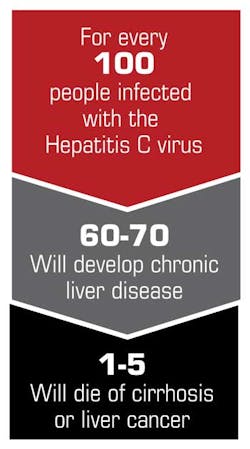Hepatitis C and Baby Boomers
by Mary Govoni, CDA, RDA, RDH, MBA
In the August 17, 2012, issue of Morbidity and Mortality Weekly Report (MMWR), the Centers for Disease Control and Prevention (CDC) issued recommendations for people born between 1945 and 1965, "baby boomers," to be screened for chronic hepatitis C infections.
Statistics indicate that chronic hepatitis C infections are prevalent in people in this age group. According to the CDC, 27% of the current U.S. population falls in this age group, and 73% of the cases of chronic hepatitis C are identified in this group. Since dental health-care workers have a slightly higher risk of exposure to hepatitis C than the general population, it stands to reason that dental professionals who are baby boomers should pay close attention to this recommendation.
Although hepatitis C (HCV) infections are acute, 60% to 70% are asymptomatic, and 70% to 85% of people infected develop chronic infections. It can take as long as 20 years for symptoms of chronic infection to manifest, and in most cases an infected individual has developed advanced liver disease. Chronic hepatitis C puts people at risk for cirrhosis, hepatocellular carcinoma, and other complications such as deata. Screening for hepatitis C infection is accomplished through a blood test, and can be ordered by your physician.
Risk factors for hepatitis C infections include:
• Having received a blood transfusion or solid organ transplant prior to July 1992
• Having received clotting factor concentrates before 1987 (hemophiliacs)
• Being in long-term dialysis
• Having experienced a needlestick injury, tattoo, or body piercing
• Being a drug abuser (injectable drugs) Source: CDC
Hepatitis C is a bloodborne infection, and was once known as "Non A-Non B" hepatitis. These infections became more common during the 1980s, according to the CDC. Hepatitis C was specifically identified in 1988, and in 1992, technology was developed to test the blood supply. This caused a significant decrease in the number of reported cases between 1992 and 2004, and the number of newly acquired cases has remained stable since.
Despite the decrease in new cases, the CDC estimates that there may be as many as 3.2 million people chronically infected in the United States. Identifying people with chronic infections is critical to treating the infection prior to the development of irreversible liver damage, as well as preventing additional transmissions of the virus.
Treatment for chronic hepatitis C infections include antiviral medications such as Pegasys™, Virazole™, and in some cases, protease inhibitors, such as Incivek™ and Victrelis™. Drug therapy for chronic hepatitis C infections typically lasts six to 12 months.
Identifying people who may be infected with chronic hepatitis C is not only important to us as health-care professionals, but also to patients. Encourage your team to be tested if they have risk factors, and encourage your patients to be tested as well. The CDC has numerous resources available for educating people about hepatitis C. It can be accessed at http://www.cdc.gov/hepatitis/C/PatientEduC.htm. These resources are available in English and Spanish.
Another helpful resource from the CDC is the new iPhone and iPad app, which puts CDC resources at your fingertips. Go to the following link for more information: http://www.cdc.gov/features/ipadapp/.
References available upon request
Mary Govoni, CDA, RDA, RDH, MBA, is the owner of Mary Govoni & Associates, a consulting company based in Michigan. She is a member of the Organization for Safety, Asepsis and Prevention. She can be contacted at [email protected] or www.marygovoni.com.


